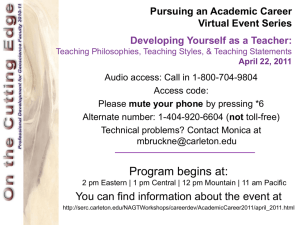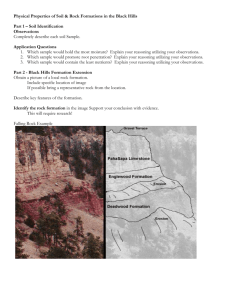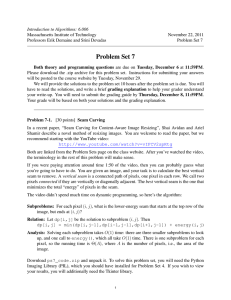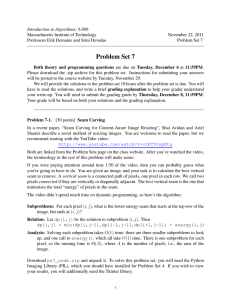MS Geotime
advertisement
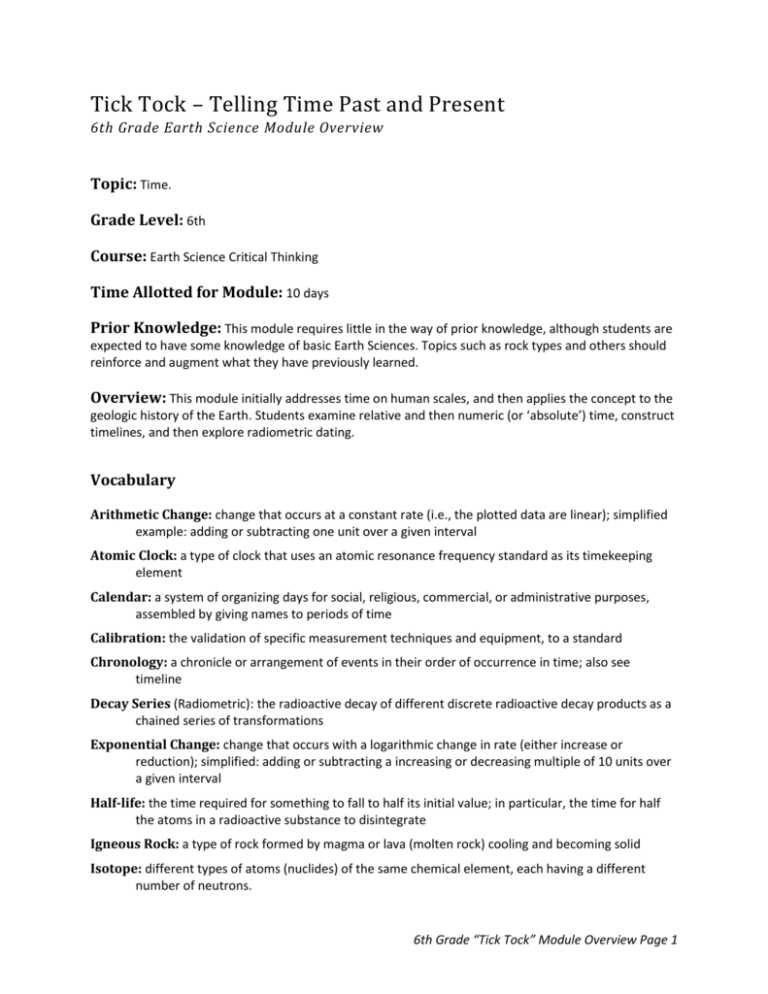
Tick Tock – Telling Time Past and Present 6th Grade Earth Science Module Overview Topic: Time. Grade Level: 6th Course: Earth Science Critical Thinking Time Allotted for Module: 10 days Prior Knowledge: This module requires little in the way of prior knowledge, although students are expected to have some knowledge of basic Earth Sciences. Topics such as rock types and others should reinforce and augment what they have previously learned. Overview: This module initially addresses time on human scales, and then applies the concept to the geologic history of the Earth. Students examine relative and then numeric (or ‘absolute’) time, construct timelines, and then explore radiometric dating. Vocabulary Arithmetic Change: change that occurs at a constant rate (i.e., the plotted data are linear); simplified example: adding or subtracting one unit over a given interval Atomic Clock: a type of clock that uses an atomic resonance frequency standard as its timekeeping element Calendar: a system of organizing days for social, religious, commercial, or administrative purposes, assembled by giving names to periods of time Calibration: the validation of specific measurement techniques and equipment, to a standard Chronology: a chronicle or arrangement of events in their order of occurrence in time; also see timeline Decay Series (Radiometric): the radioactive decay of different discrete radioactive decay products as a chained series of transformations Exponential Change: change that occurs with a logarithmic change in rate (either increase or reduction); simplified: adding or subtracting a increasing or decreasing multiple of 10 units over a given interval Half-life: the time required for something to fall to half its initial value; in particular, the time for half the atoms in a radioactive substance to disintegrate Igneous Rock: a type of rock formed by magma or lava (molten rock) cooling and becoming solid Isotope: different types of atoms (nuclides) of the same chemical element, each having a different number of neutrons. 6th Grade “Tick Tock” Module Overview Page 1 Metamorphic Rock: a type of rock that is formed as pressure and/or temperature changes, generally during burial or mountain building Radiometric Dating: a technique used to date materials, usually based on a comparison between the observed abundance of a naturally occurring radioactive isotope and its decay products, using known decay rates Relative Dating: the science of determining the relative order of past events, without necessarily determining their absolute age Sedimentary Rock: a type of rock that is formed by processes that cause mineral and/or organic particles (detritus) to settle and accumulate, or minerals to precipitate from a solution Steno’s Principles: a group of stratigraphic principles attributed to Nicolas Steno, a pioneering Danish geologist, including lateral continuity, original horizontality and superposition (see definitions of these terms below) Lateral Continuity: material forming a stratum that is continuous over the surface of the Earth unless some other solid bodies stood in the way Original Horizontality: sediments are deposited under the influence of gravity as nearly horizontal beds; if folded or faulted strata are found, the layers were deformed by tectonic forces after the sediments were deposited Superposition: at the time when any given stratum was being formed, all the matter resting upon it was fluid, and, therefore, at the time when the lower stratum was being formed, none of the upper strata existed Stratum (pl. Strata): a horizontal layer of rock Time: the sequence of events Timeline: a visualization of a sequence of events, used in education, history and a variety of sciences including geology, cosmology and biology 6th Grade “Tick Tock” Module Overview Page 2 Materials All students should have their own science notebooks for ALL activities DAYS 1-2 Two small, plastic bottles (e.g. 16-32 oz. soda bottles) Sand or salt Masking or duct tape Thick aluminum foil or Coffee can Glass or clear plastic container to collect water Small nail Hammer Sharp pencil Marker Wristwatch or classroom clock for calibration (should have a second hand). Candles and matches (optional; see below) DAY 3 Easel paper (preferably gridded) or 8” x 11” graph paper (then the scale needs to be adjusted) or use the file ‘Timeline Sheet’ as the basis for this Colored markers DAY 5-7 A number of glass, graduated cylinders (enough for students working in groups of 3 or 4) At least four types of sediment (nothing too fine grained as things like clay will not settle quickly) Funnel DAYS 8-10 100 pennies per group Shoe box (one per group) Science Standards Big Idea 1: The Practice of Science Big Idea 2: The Characteristics of Scientific Knowledge Big Idea 3: The Role of Theories, Laws, Hypotheses, and Models Big Idea 6: Earth Structures SC.6.E.6.1 Describe and give examples of ways in which Earth's surface is built up and torn down by physical and chemical weathering, erosion, and deposition. Math Standards Big Idea 1: (Multiplying decimals) Develop an understanding of and fluency with multiplication and division of fractions and decimals. MA.6.A.1.3 Solve real-world problems involving multiplication and division of fractions and decimals. Supporting Idea 6: Data Analysis MA.6.S.6.1 Determine the measures of central tendency (mean, median, mode) and variability (range) for a given set of data. MA.6.S.6.2 Select and analyze the measures of central tendency or variability to represent, describe, analyze, and/or summarize a data set for the purposes of answering questions appropriately. 6th Grade “Tick Tock” Module Overview Page 3 References Activity1.pdf http://serc.carleton.edu/NAGTWorkshops/intro/activities/23346.html Activity1_IN.pdf http://serc.carleton.edu/NAGTWorkshops/intro/activities/23346.html AgeDetermination.pdf teacher-created Evolution of Calendars.pdf http://moonsighting.com/articles/evolution.html BasltRock.pdf http://www.pitt.edu/~cejones/GeoImages/5SedimentaryRocks/Carbonates/BioclasticLimestones/Lime stoneCrinoidalCUp.jpg Creating Timeline Activity http://www.ourtimelines.com/ Evolution of Calendars.pdf http://moonsighting.com/articles/evolution.html ExcelWorksheet_HeadsUp.xls http://www.techonthenet.com/excel/charts/2_y_axes.php GeoPrinciples.pdf http://geowords.com/histbookpdf/a19.pdf Handout_StenosPrinciples.pdf teacher-created HowMuchis1Million.pdf http://www.emints.org/ethemes/resources/S00001120.shtml IgneousRock.pdf http://www.pitt.edu/~cejones/GeoImages/2IgneousRocks/IgneousCompositions/3Basalt/BasaltSmallV esicOlPheno.jpg LifeLines.pdf http://serc.carleton.edu/NAGTWorkshops/affective/activities/16669.html LifeLines_IN.pdf http://serc.carleton.edu/NAGTWorkshops/affective/activities/16669.html MegaPenny.pdf http://www.kokogiak.com/megapenny/default.asp NAImeasureofdeeptime.pdf http://nai.nasa.gov/news_stories/news_detail.cfm?ID=291 Passage of Time.pdf http://hea-www.harvard.edu/ECT/the_book/Chap3/Chapter3.html 6th Grade “Tick Tock” Module Overview Page 4 Radiometric Dating.pdf http://www.asa3.org/ASA/RESOURCES/WIENS.html RelativeDatingTips.pdf http://serc.carleton.edu/teacherprep/resources/activities/relative-dating.html StemoArticle.pdf http://earthobservatory.nasa.gov/Features/Steno/steno5.php Walk Through Time Activity http://www.nist.gov/physlab/general/time/index.cfm 6th Grade “Tick Tock” Module Overview Page 5


